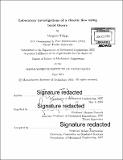Laboratory investigations of a chaotic flow using braid theory
Author(s)
Filippi, Margaux (Martin-Filippi)
DownloadFull printable version (12.36Mb)
Other Contributors
Massachusetts Institute of Technology. Department of Mechanical Engineering.
Advisor
Thomas Peacock.
Terms of use
Metadata
Show full item recordAbstract
Describing transport in fluid flows has been a long-standing challenge in dynamical systems theory, with applications to industrial and natural flows. The detection of Lagrangian structures that stay coherent over time helps gain insight into the evolution of a system's dynamics and the fate of transport. Whereas most techniques to detect coherent structures rely on a dense velocity field, techniques based on sparse datasets are increasingly being developed. The braid theory approach to detect Lagrangian coherent structures from sparse sets of trajectories is tested through a periodic, two-dimensional Stokes flow, the rotor-oscillator flow. Combined theoretical and numerical studies have shown that this flow can offer chaotic regimes with islands of coherence. The flow was recreated experimentally in a laboratory based on the findings of these theoretical studies. The braid theory approach was found to successfully detect coherent groups from sparse trajectories, although it is very sensitive to the quality of that data available.
Description
Thesis: S.M., Massachusetts Institute of Technology, Department of Mechanical Engineering, 2016. Cataloged from PDF version of thesis. Includes bibliographical references (pages 95-98).
Date issued
2016Department
Massachusetts Institute of Technology. Department of Mechanical EngineeringPublisher
Massachusetts Institute of Technology
Keywords
Mechanical Engineering.